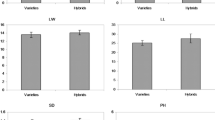Summary
Interspecific hybrids were generated from crosses between 4 Zinnia angustifolia clones (maternal parents) and an inbred line of Z. elegans ‘Orange King’ (paternal parent) to investigate the influence of Z. angustifolia genotype on morphology and flowering of hybrids. Leaf length, leaf width, flower diameter, number of ray petals, and days to flowering of interspecific hybrids were significantly influenced by Z. angustifolia clonal genotype. Genetic analysis of hybrid morphology and development was performed using 2 parental Z. angustifolia clones and 18 F1 (9 seedlings from each of 2 populations generated from reciprocal crosses between parental clones) as maternal parents in crosses with Z. elegans ‘Orange King’. Genotype of Z. angustifolia significantly affected plant height, fresh weight, number of nodes, and days to flowering of interspecific hybrids. Control of these traits was through the Z. angustifolia nuclear genome. Improvement in interspecific hybrid morphology or development, i.e., shorter stature, earlier flowering, or larger flowers, may be possible by selection of superior-performing Z. angustifolia clones as parents.
Similar content being viewed by others
References
Andersen, K., 1971. The behavior of powdery mildew conidia (Erysiphe cichoracearum) on the leaves of resistant and susceptible species of Zinnia. M. Sc. Thesis, Pennsylvania State University, USA.
Boyle, T.H. & D.P. Stimart, 1982. Interspecific hybrids of Zinnia elegans Jacq. and Z. angustifolia HBK: embryology, morphology and powdery mildew resistance. Euphytica 31: 857–867.
Boyle, T.H. & D.P. Stimart, 1983. Developmental responses of Zinnia to photoperiod. J. Am. Soc. Hort. Sci. 108: 1053–1059.
Boyle, T.H. & D.P.Stimart, 1986. Self-incompatibility and interspecific incompatibility: relationships in intra- and interspecific crosses of Zinnia elegans Jacq. and Z. angustifolia HBK (Compositae). Theor. Appl. Genet. 73: 305–315.
Boyle, T.H., D.P. Stimart & M.S. McIntosh, 1986. Seasonal variation in vegatative and reproductive development in Zinnia elegans Jacq. J. Am. Soc. Hort. Sci. 111: 260–266.
Boyle, T.H., D.P. Stimart & G.R. Bauchan, 1987. Influence of Zinnia angustifolia HBK genotype on embryonic and vegetative development of Z. angustifolia × Z. elegans Jacq. interspecific hybrids. Theor. Appl. Genet. 73: 716–723.
Briggs, F.N. & P.F. Knowles, 1967. Introduction to plant breeding. Reinhold Publishing Corp, New York.
Chen, N.C., L.R. Baker & S. Honma, 1983. Interspecific crossability among four species of Vigna food legumes. Euphytica 32: 925–937.
Custers, J.B.M. & P.M.Den Nijs, 1986. Effects of aminoethoxyvinylglycine (AVG), environment, and genotype in overcoming hybridization barriers between Cucumis species. Euphytica 35: 639–647.
Gomez, K.A. & A.A. Gomez, 1984. Statistical procedures for agricultural research, second edition. John Wiley & Sons, New York.
Hadley, H.H. & S.J. Openshaw, 1980. Interspecific and intergeneric hybridization. In: W.R. Fehr & H.H. Hadley, (Eds). Hybridization of crop plants. American Society of Agronomy and Crop Science Society of America, Madison, Wisconsin USA, pp. 133–159.
Harlan, J.R. & J.M.J.de Wet, 1977. Pathways of genetic transfer from Tripsacum to Zea mays. Proc. Natl. Acad. Sci. USA 74: 3494–3497.
Hoven, A.W., 1962. Interspecific hybridization between Trifolium repens L. and T. nigrescens Viv. and analysis of hybrid meiosis. Crop Sci. 2: 251–254.
Jones, J.J. & D.L. Strider, 1979. Susceptibility of zinnia cultivars to bacterial leaf spot caused by Xanthomonas nigromaculans sp. zinniae. Plant Dis. Rep. 63: 449–453.
Lipschutz, L., 1965. The resistance of Zinnia species to Alternaria zinniae Pape. M. Sc. Thesis, Pennsylvania State University, USA.
Pittarelli, G.W. & J.R. Stavely, 1975. Direct hybridization of Nicotiana repanda × N. tabacum. J. Hered. 66: 281–284.
Stebbins, G.L., 1958. The inviability, weakness, and sterility of interspecific hybrids. In: M. Demerec, (Ed.). Advances in genetics, vol IX. Academic Press, New York, pp. 147–215.
Terry-Lewandowski, V.M. & D.P. Stimart, 1983. Multiple resistance in induced amphiploids of Zinnia elegans and Zinnia angustifolia. Can. J. Genet. Cytol. 26: 40–45.
Torres, A.M., 1963. Taxonomy of Zinnia. Brittonia 15: 1–25.
Author information
Authors and Affiliations
Rights and permissions
About this article
Cite this article
Boyle, T.H., Stimart, D.P. Effect of Zinnia angustifolia HBK genotype on morphology and flowering of Z. angustifolia × Z. elegans Jacq. hybrids. Euphytica 44, 73–79 (1989). https://doi.org/10.1007/BF00022602
Received:
Accepted:
Issue Date:
DOI: https://doi.org/10.1007/BF00022602




